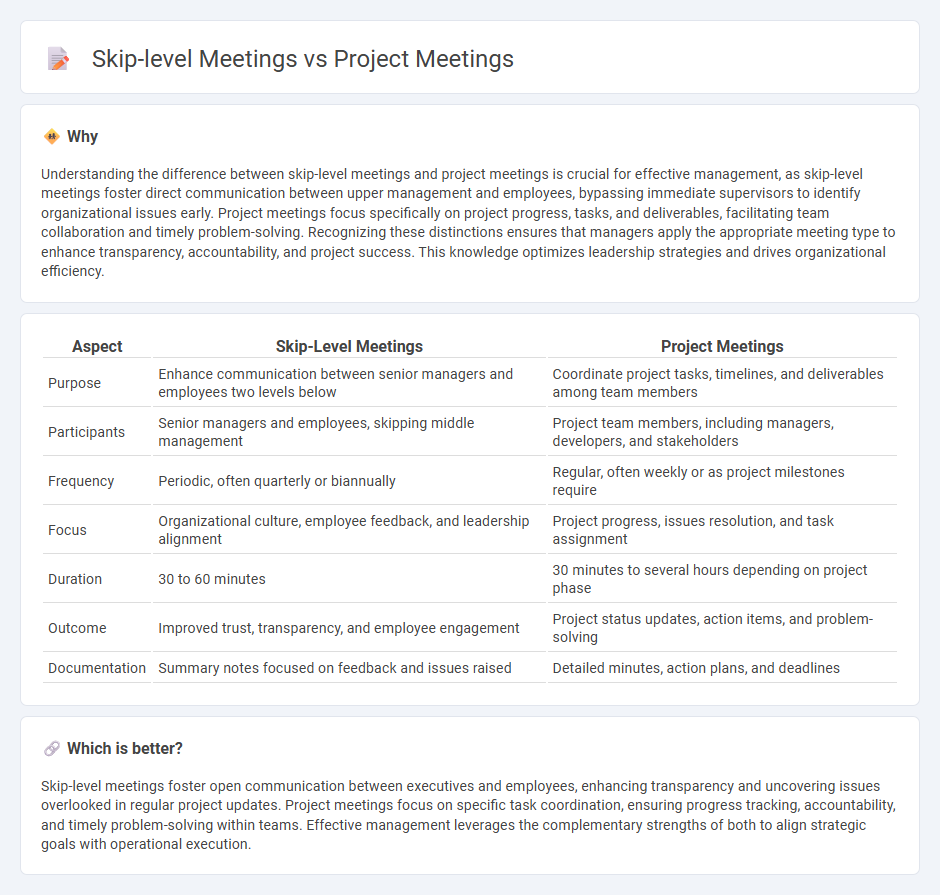
Skip-level meetings focus on fostering direct communication between senior leaders and employees two or more levels below, enhancing transparency and uncovering workplace challenges. Project meetings concentrate on specific team goals, progress updates, task coordination, and problem-solving to ensure timely project delivery. Explore how these meetings improve organizational effectiveness and employee engagement.
Why it is important
Understanding the difference between skip-level meetings and project meetings is crucial for effective management, as skip-level meetings foster direct communication between upper management and employees, bypassing immediate supervisors to identify organizational issues early. Project meetings focus specifically on project progress, tasks, and deliverables, facilitating team collaboration and timely problem-solving. Recognizing these distinctions ensures that managers apply the appropriate meeting type to enhance transparency, accountability, and project success. This knowledge optimizes leadership strategies and drives organizational efficiency.
Comparison Table
| Aspect | Skip-Level Meetings | Project Meetings |
|---|---|---|
| Purpose | Enhance communication between senior managers and employees two levels below | Coordinate project tasks, timelines, and deliverables among team members |
| Participants | Senior managers and employees, skipping middle management | Project team members, including managers, developers, and stakeholders |
| Frequency | Periodic, often quarterly or biannually | Regular, often weekly or as project milestones require |
| Focus | Organizational culture, employee feedback, and leadership alignment | Project progress, issues resolution, and task assignment |
| Duration | 30 to 60 minutes | 30 minutes to several hours depending on project phase |
| Outcome | Improved trust, transparency, and employee engagement | Project status updates, action items, and problem-solving |
| Documentation | Summary notes focused on feedback and issues raised | Detailed minutes, action plans, and deadlines |
Which is better?
Skip-level meetings foster open communication between executives and employees, enhancing transparency and uncovering issues overlooked in regular project updates. Project meetings focus on specific task coordination, ensuring progress tracking, accountability, and timely problem-solving within teams. Effective management leverages the complementary strengths of both to align strategic goals with operational execution.
Connection
Skip-level meetings enhance organizational transparency by enabling senior managers to directly engage with employees, fostering open communication and identifying project challenges early. Project meetings provide a structured forum for cross-functional teams to track progress, address issues, and align on objectives, which supports informed discussions during skip-level interactions. Integrating insights from project meetings into skip-level meetings promotes strategic decision-making and continuous improvement across management layers.
Key Terms
**Project Meetings:**
Project meetings center on coordinating tasks, tracking progress, and resolving issues among team members directly involved in project execution. They facilitate clear communication, align goals, and ensure deadlines are met through detailed status updates and collaborative problem-solving. Discover essential strategies to enhance the effectiveness of project meetings and drive successful outcomes.
Agenda
Project meetings concentrate on task progress, deliverables, and timeline alignment to ensure project milestones are met efficiently. Skip-level meetings prioritize open communication between higher management and team members, addressing broader challenges and fostering transparency without intermediate supervisor involvement. Explore strategies to optimize agendas for both meeting types to boost productivity and engagement.
Action Items
Project meetings concentrate on reviewing progress, assigning tasks, and resolving immediate challenges to ensure timely completion of deliverables. Skip-level meetings emphasize direct communication between employees and higher management to address broader concerns, align strategies, and enhance organizational transparency. Discover how aligning action items in both meeting types can drive effective decision-making and improved team performance.
Source and External Links
10 Project Meetings to Guide Your Project Management - Project meetings are regularly scheduled events with the team and stakeholders to discuss progress, solve problems, and improve collaboration, with key types including kickoff, status, review, and sprint meetings essential for project communication and success.
16 Types of Meetings and Why They're Important - Project management meetings typically include brainstorming sessions, project-planning meetings, kickoff meetings, and check-ins to clarify roles, discuss milestones, and generate ideas to keep the project on track.
What is a Project Meeting? - A project meeting is a regular event involving all stakeholders to communicate, review progress, discuss issues, approve changes, and make group decisions that enable timely delivery according to goals.
 dowidth.com
dowidth.com